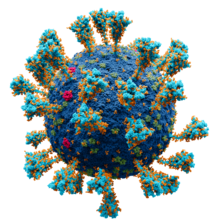Spike protein: Difference between revisions
→Society and culture: removal of clear misinformation sourced from a false statement. several points raised were without citation entirely. terminology was inaccurate and the grammar of the removed statement was improper. Tags: references removed Mobile edit Mobile web edit |
High quality large image. FP on Commons. Scientifically accurate atomic model of the external structure of the SARS-CoV-2 + ref. |
||
| Line 2: | Line 2: | ||
{{More citations needed|article|date=November 2018}} |
{{More citations needed|article|date=November 2018}} |
||
[[file:Coronavirus. SARS-CoV-2.png|thumb|The peplomers (turquoise and green) of a [[SARS-CoV-2]], the virus that causes [[COVID-19]].<ref>{{cite web |surname1=Solodovnikov | given1=Alexey |surname2=Arkhipova| given2=Valeria |title = Достоверно красиво: как мы сделали 3D-модель SARS-CoV-2 |trans-title=Truly beautiful: how we made the SARS-CoV-2 3D model |url = https://nplus1.ru/blog/2021/07/29/sars-cov-2-model |archive-url = https://web.archive.org/web/20210730143142/https://nplus1.ru/blog/2021/07/29/sars-cov-2-model |publisher= [[w:ru:N+1|N+1]] |archive-date=2021-07-30 |date =2021-07-29 |access-date=30 July 2021 |language =ru}}</ref>]] |
|||
[[file:SARS-CoV-2 without background.png|thumb|The peplomers (red and orange) of a [[SARS-CoV-2]], the virus that causes [[COVID-19]].]] |
|||
[[File:Novel Coronavirus SARS-CoV-2 Spike Protein (49583626473).jpg|thumb|[[3D print]] of one of the peplomers of [[SARS-CoV-2]]]] |
[[File:Novel Coronavirus SARS-CoV-2 Spike Protein (49583626473).jpg|thumb|[[3D print]] of one of the peplomers of [[SARS-CoV-2]]]] |
||
Revision as of 00:59, 1 August 2021
This article needs additional citations for verification. (November 2018) |


Spike proteins, also known as peplomers (Greek: peplos 'robe', '[woman's] dress' + meros 'part'), are the knoblike structures generally composed of glycoproteins, projecting from the lipid bilayer of the surface of an enveloped virus. Peplomers play important roles in the infection process; they are responsible for the attachment of the virus particle or virion to receptor sites on the host cell's surface, and bringing about the release of the nucleocapsid containing the virus's genetic material into the host cell's cytoplasm by triggering fusion between the envelope and host membranes. They may have hemagglutinating activity or have enzyme activity such as neuraminidase. They are surface antigens.[2][3][4][5]
The term peplomer is rarely used today[citation needed] and is no longer used for all outwardly protruding envelope proteins; it is mostly replaced by the less precise expression spike. However, this suggests a pointed structure, which is not the case with these envelope structures; they are round, flattened or button-shaped on the outside. Both terms, peplomer and spike, however, only describe a morphologically visible structure and are not identical to the expression membrane protein or coat protein; many other membrane proteins in viruses do not form these prominent structures.
Virus types
Peplomers can be seen in electron micrographs on the surface of enveloped viruses such as Orthomyxoviruses, Paramyxoviruses, Rhabdoviruses, Filoviruses, Coronaviruses, Bunyaviruses, Arenaviruses, and Retroviruses.[6]
Antivirals
Bamlanivimab/etesevimab is a mix of two types of monoclonal antibody that target the surface spike protein of SARS-CoV-2.[7][8]
Society and culture
During the COVID-19 pandemic, anti-vaccination misinformation circulated on based social media platforms saying that spike proteins were dangerously "cytotoxic" and that mRNA vaccines containing them were therefore in themselves dangerous.
See also
References
- ^ Solodovnikov, Alexey; Arkhipova, Valeria (29 July 2021). "Достоверно красиво: как мы сделали 3D-модель SARS-CoV-2" [Truly beautiful: how we made the SARS-CoV-2 3D model] (in Russian). N+1. Archived from the original on 30 July 2021. Retrieved 30 July 2021.
- ^ Brian Mahy. The Dictionary of Virology. 4th Edition 2009.
- ^ Taber's Cyclopedic Medical Dictionary (21st ed.). F. A. Davis Company. 2009.
- ^ Dorland's Illustrated Medical Dictionary (32nd Edition). Saunders 2011.
- ^ Saunders Comprehensive Veterinary Dictionary (3rd ed.). Elsevier, Inc. 2007. as cited in "peplomer". The Free Dictionary. Farlex. 2011. Retrieved 30 March 2011.
- ^ Christopher J. Burrell, Colin R. Howard, Frederick A. Murphy. Fenner and White’s Medical Virology. Fifth Edition. 2017
- ^ "etesevimab". IUPHAR/BPS Guide to Pharmacology. Retrieved 10 February 2021.
- ^ "Lilly announces agreement with U.S. government to supply 300,000 vials of investigational neutralizing antibody bamlanivimab (LY-CoV555) in an effort to fight COVID-19". Eli Lilly and Company (Press release). 28 October 2020.
Further reading
- F. Fenner et al.: The Biology of Animal Viruses, 2. Auflage, New York, London 1968, ISBN 0-12-253040-3, S. 5f
- D. J. Garwes et al.: Identification of epitopes of immunological importance on the peplomer of porcine transmissible gastroenteritis virus. Adv Exp Med Biol. (1987) 218: S. 509–515, PMID 2449047
- H. G. Niesters et al.: The peplomer protein sequence of the M41 strain of coronavirus IBV and its comparison with Beaudette strains. Virus Res. (1986) 5(2-3): S. 253–263, PMID 2429473
